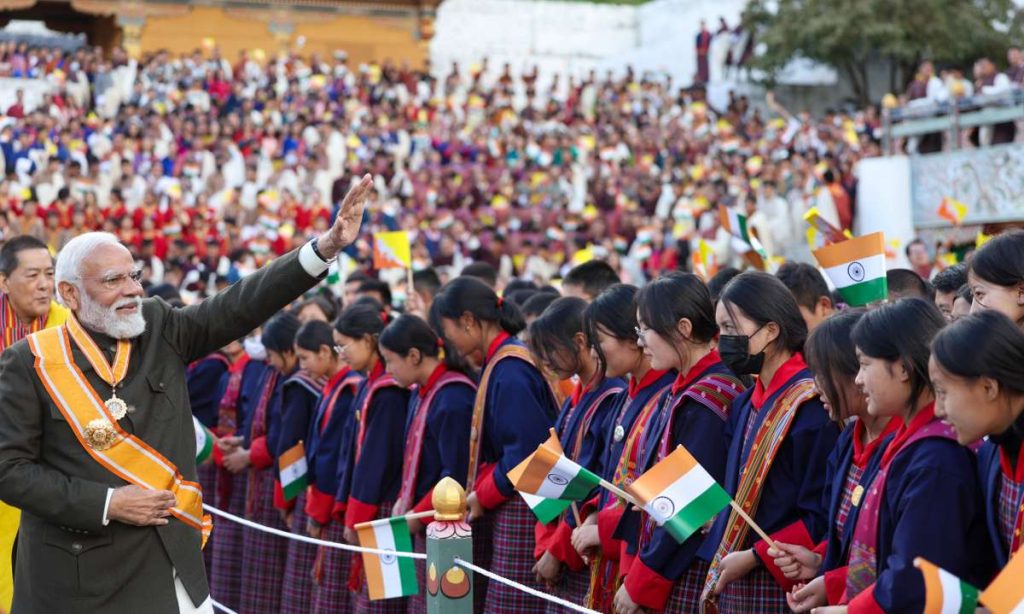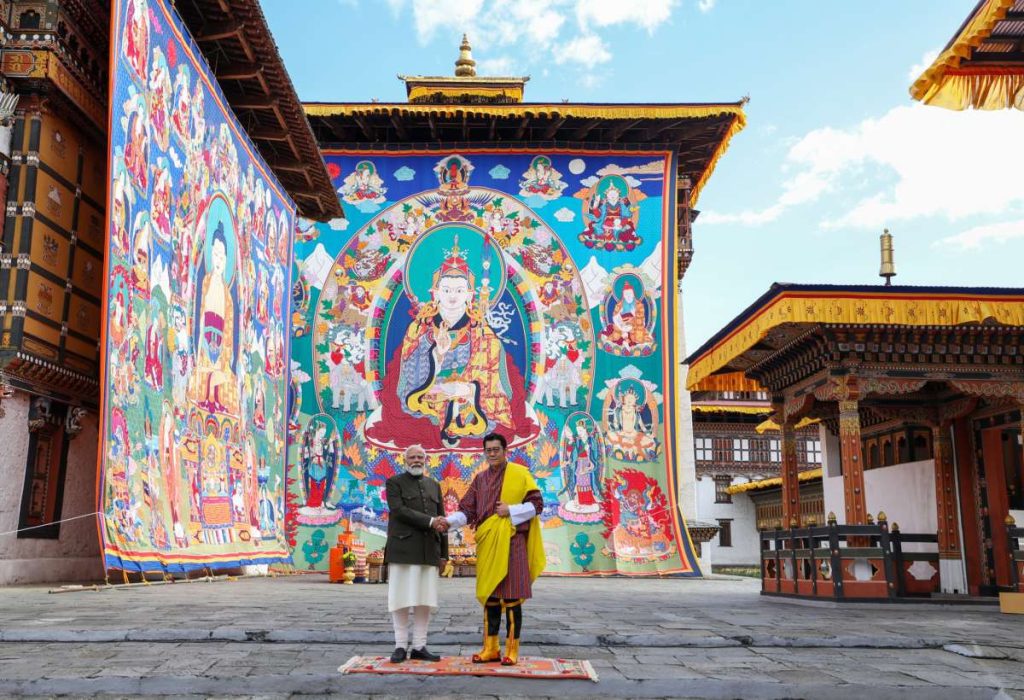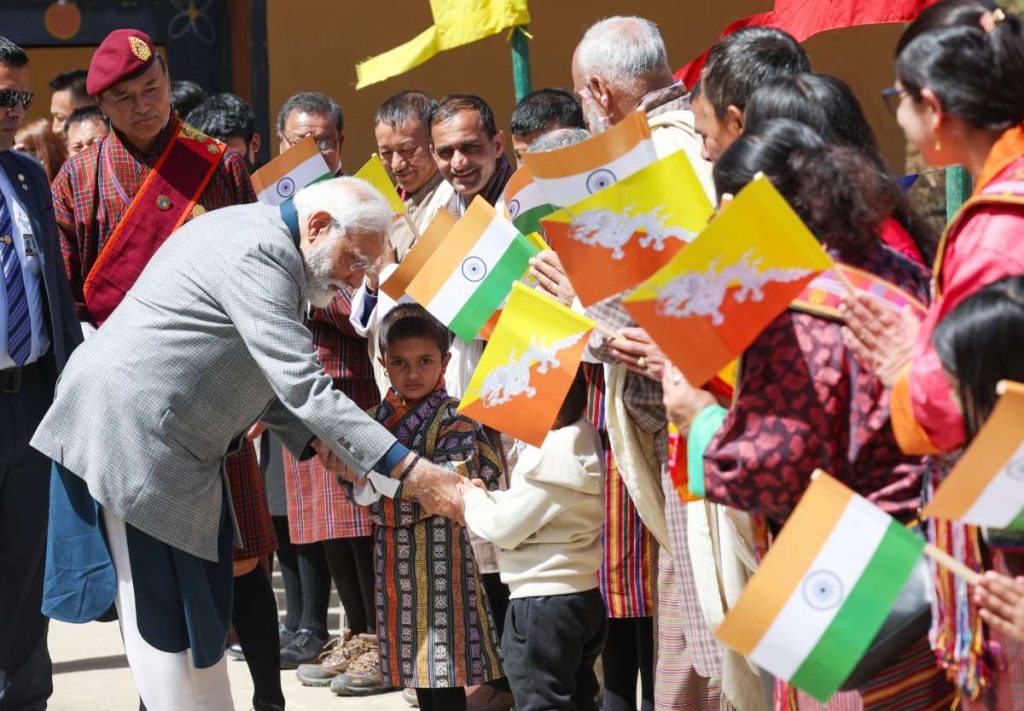
The age-old ties between India and Bhutan received a significant boost following Prime Minister Modi’s recent visit to Thimphu, writes Srikanth Kondapalli…reports Asian Lite news
Prime Minister Narendra D. Modi concluded a two-day visit to the Himalayan Kingdom of Bhutan on March 23. The age-old ties were renewed with the visit and several firsts were made.
Even though a model code of conduct has commenced with the General Elections plan announced and political campaigning across the country is picking up, the Prime Minister thought it wise to visit and renew ties with Bhutan, despite also the fact that the two Prime Ministers met at Delhi a week ago.
PM Modi was conferred with the highest civilian award of “Order of the Druk Gyalpo” thus Bhutan sent a message of its close relations with India. Also, not only the PM of Bhutan Tshering Tobgay received PM Modi at the Paro airport but he and the King Jigme Khesar Namgyel Wangchuck saw him off after the successful visit.
Bhutan also sent warm signals by mobilising people to greet PM Modi all along the 45 kilometer stretch from Paro airport to the capital Thimphu. The visit also comes after postponing the original schedule due to heavy rains in Bhutan.

Significance of visit
However, apart from these symbolic gestures, more substantive outcomes of the visit are seen at the bilateral and regional levels. First is to affirm the close ties between the two countries. PM Modi assured his hosts that “India will always be a reliable friend and partner for Bhutan”.
This is in line with the traditional amity and cooperation between the two countries since the India-Bhutan Treaty of Perpetual Peace and Friendship of 1949, that was amended as Treaty of Friendship Treaty in 2007, and the establishment of diplomatic ties in 1968.
India had nudged Bhutan to join the United Nations and the World Bank and was happy to see Bhutan’s graduation from the Least Developed Countries last year and also pledged assistance in its quest to become a high-income nation by 2034.
Secondly, seven agreements were signed during the visit, including thousands of crore rupees extended to Bhutan as aid. India pledged over 5,000 crores to Bhutan’s 12th Five Year Plan and plans to double this amount for the next 13th Five Year Plan.

Massive infrastructure projects are to be constructed as a part of this cooperation including the completed 720 MW Mangdechhu Hydro-electric Project and soon to be completed 1020 MW Punatshangchhu-II hydropower project. There is also the connectivity between Bhutan and Assam and West Bengal through two rail projects linking Banarhat (in West Bengal) with Samtse (in Bhutan) and Kokrajhar (in Assam) with Gelephu (in Bhutan).
In addition, India extended 1500 crores for skill development. Also, during PM Modi’s visit the state-of-the-art 141 crore worth Gyaltsuen Jetsun Pema Wangchuck Mother and Child Hospital was inaugurated. India is also planning space cooperation, artificial intelligence, digital public infrastructure, and STEM education with Bhutan.
Thirdly, and most significantly, at the regional level, is to keep China at bay. In recent years, China has been exerting pounding pressure in South Asia as with the other regions of the world in its quest for global and regional hegemony. Successive governments in China since the 19th century have laid claims to Bhutanese territory.
China’s expansionist design
In recent times, China’s voracious territorial claims across its neighborhood and beyond are expanding rapidly. Despite its package deal of 1996, treaty to maintain peace and tranquility with Bhutan in 1998 and the 2012 three-step road map to resolve the territorial dispute, China has not only been extending its territorial claims over Bhutan but actually grabbing land.
In June 2020, China laid claim to 650 sq.km of Sakteng Wildlife Sanctuary in Bhutan’s eastern district of Trashigang and began road construction.
In 2017, China began constructing a road through Bhutanese claimed land in Doklam plateau leading India to protect Bhutanese interests in the 72-day military standoff with Chinese military forces.
Today, China is building semi military “well-off society villages” in the neighbourhood of India, Bhutan, Nepal and other countries. For instance, at Pangda village China built 28 houses which are about two and half kilometers inside Bhutan.
Similar construction activities by China are seen at Gyalaphug (Doklam Plateau 2015), Menchuma, Dermalumg, Mabjathang, Sedewo and other villages on Bhutan borders. China intends to use these to support Chinese military outposts or to facilitate the migration of Chinese citizens into Bhutanese territory in future. This has unnerved Bhutan.

Conclusion
For India as well China’s Belt and Road Initiative “debt diplomacy” in South Asia is creating financial and strategic challenges.
Sri Lankan economic meltdown two years ago necessitated India providing $4 billion in aid. Nepal, Maldives and Pakistan are also becoming basket cases and heavily in debt to China.
India also has to consider the nascent but motivated “India out” campaign in Maldives, Bangladesh and other countries.
Keeping these trends in mind, the joint statement of India and Bhutan highlighted the “exceptional neighbourly ties” between the two countries and mentioned: “We express satisfaction with the cooperation between our two countries related to our mutual security. We agree to continue with our close coordination and cooperation with each other on issues relating to our national interests”. PM Modi’s visit then reiterated the “Neighbourhood First Policy.”
(The writer is Professor in Chinese Studies at JNU; views expressed here are his own) – India News Network
ALSO READ: Jaishankar Seeks to Enhance India-Malaysia Cooperation


